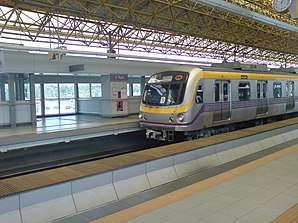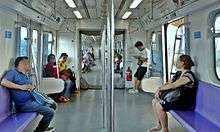LRTA 2000 class
The LRTA 2000 class is a class of electric multiple units of the Light Rail Transit Authority (LRTA) in Metro Manila, Philippines, which began operation in 2003. It is used in Line 2.[1]
| LRTA 2000 class | |
|---|---|
 | |
| In service | 2003–present |
| Manufacturer | ROTEM (→Hyundai Rotem) |
| Built at | South Korea |
| Constructed | 2001–2003 |
| Entered service | April 5, 2003 |
| Number built | 72 vehicles (18 4–car sets) |
| Number in service | 32 vehicles (8 4–car sets) |
| Formation | Mc - M - M - Mc |
| Capacity | Head cars: 392 Intermediate cars: 422 Total crush load: 1,628 |
| Operator(s) | Light Rail Transit Authority |
| Depot(s) | Santolan |
| Line(s) served | Line 2 |
| Specifications | |
| Car body construction | Car body shell: Stainless steel Under frame: Stainless steel and LAHT steel Interior lining: Melamine and/or polyester faced ply metal |
| Train length | 92,600 mm (303 ft 10 in) (over anti-climber) |
| Car length | 23,800 mm (78 ft 1 in) (Head car) 22,500 mm (73 ft 10 in) (Intermediate car) |
| Width | 3,200 mm (10 ft 6 in) |
| Height | 4,100 mm (13 ft 5 in) |
| Floor height | 1,100 mm (3 ft 7 in) |
| Doors | 5 per side |
| Wheel diameter | 850mm (new) |
| Wheelbase | 2,300 mm (7 ft 7 in) |
| Maximum speed | 80 km/h (50 mph) |
| Weight | 152,000 kg (4–car train set) |
| Traction system | (Toshiba) IGBT-VVVF |
| Traction motors | Three-phase induction motor(Toshiba) |
| Power output | 120 kW |
| Transmission | WN drive |
| Acceleration | 1.3 m/s² (4.26 ft/s²) |
| Deceleration | Service: 1.3 m/s² (4.26 ft/s²) Emergency: 1.5 m/s² (4.92 ft/s²) |
| Power supply | 34.5kV AC |
| Electric system(s) | 1500V DC overhead wire |
| Current collection method | Single-arm pantograph |
| Bogies | Bolsterless type |
| Braking system(s) | Dynamic (regenerative and rheostatic) Pneumatic disk |
| Safety system(s) | Automatic Train Control (ATC) ATP ATO ATS |
| Coupling system | EMU cab ends: Mechanical, Shibata-type Between cars (non-cab ends): Semi-pernament couplers |
| Track gauge | 1,435 mm (4 ft 8 1⁄2 in) |
| Notes | |
| Key features are taken from these sources.[1][2][3][4] | |
Purchase
The trains are manufactured by Hyundai Rotem, and the electric products were made by Toshiba. A total of 72 cars were produced between 2002 and 2003 to service in Line 2.[5]
Design
Exterior
The car body is made of stainless steel, and the under frame shares the similar material with LAHT steel.
The trains sport a livery of yellow and purple cheatlines. The upper yellow lines represent mango, the unofficial national fruit. The thicker purple lines are based from the ube, and it sports a geometric ethnic design.[6]
The trains have round front ends, which bears resemblance to the 2nd-generation trains of Seoul Metro Line 1, Line 4, and Bundang Line; these EMUs are also manufactured by Rotem (or then KOROS).[7]
Trains prominently use wrap advertising.
 2000 class train with wrap advertising.
2000 class train with wrap advertising. Interior of a 2000 class train.
Interior of a 2000 class train.
Interior
The inner train space is lined with melamine and/or polyester faced ply metal. The windows are tinted safety glass, and the longitudinal seats are made of fiberglass reinforced plastics.[8] The flooring is of stainless steel keystone plate and a thick, nonslip covering. Open-type gangways are present in between cars. These are 1,500 millimetres (4 ft 11 in) wide. In 2017, some trains are retrofitted with the Passenger Assist Railway Display System (now known as TUBE), a passenger information system powered by LCD screens installed near the inner ceiling of the trains that shows news, advertisements, current train location, arrivals and station layouts.[9]
Traction equipment
The bogie is a bolsterless type, the axle length is 2,200 millimetres (7 ft 3 in), the bogie center length is 1,580 millimetres (5 ft 2 in) The primary suspension consists of a conical rubber suspension and the secondary suspension is a diaphragm air spring.
Traction converter is IGBT-VVVF type, and one inverter is installed in each. The traction motor is a 120 kW three-phase AC induction motor.[10]
Operations
The trains currently run in 8 sets, with 8 trains being repaired/overhauled and 2 being repaired from a collision between Araneta Center-Cubao and Anonas Stations.[11]
Incidents
See also
| Wikimedia Commons has media related to LRTA Class 2000. |
References
- "Railway Systems-Project Record View". Hyundai Rotem. Retrieved 2016-07-17.
- JICA 2011.
- LRTA & PPP 2014, p. 7.
- Light Rail Transit Authority 2017, p. 11, 15, 16.
- LRTA 2014.
- "Ultra modern Line 2 trains arrive at Manila" (Press release). Manila: Philstar. 2002-11-24. Retrieved 2020-05-23.
- "Hyundai Rotem Portfolio". Hyundai Rotem. 2009. Retrieved 2020-05-23.
- Light Rail Transit Authority 2017, p. 16.
- "Line 2 unveils PARDS for passengers". Metro Manila: ABS-CBN. ANC. 2017-05-06. Retrieved 2020-05-23.
- Light Rail Transit Authority 2017, p. 15.
- "Longer waiting times seen after Line 2 collision". Manila: ABS-CBN. 2019-05-19. Retrieved 2020-05-15.
Further reading
- LRTA (2014). Line 2 Operations and Maintenance Project Information Memorandum (PDF) (Report). Public-Private Partnership Center, Philippines. Retrieved 2020-05-23.
- Light Rail Transit Authority (August 9, 2017). Maintenance of the Manila LRT Line 2 System, Terms of Reference (PDF) (Report). Light Rail Transit Philippines. Archived from the original on June 11, 2020. Retrieved 2020-05-23.
- Hyundai Rotem. "Hyundai Rotem Project Record View". Hyundai Rotem. Retrieved 2020-05-15.
- "Dōnyū jisseki: Tetsudō shisutemu: Tōshiba (Ajia Oseania)" 導入実績:鉄道システム:東芝(アジア・オセアニア) [Toshiba installation record for railway systems (Asia/Oceania)]. Toshiba. Retrieved 2020-06-12.
- JICA (2015). Firipin kuni Line 2-gōsen enshin keikaku junbi chōsa fainaru repōto フィリピン国Line 2号線延伸計画準備調査ファイナル・レポート [Preparatory study for Philippines Line 2 extension project, final report] (PDF) (Report). Japan International Cooperation Agency. Retrieved 2020-05-15.